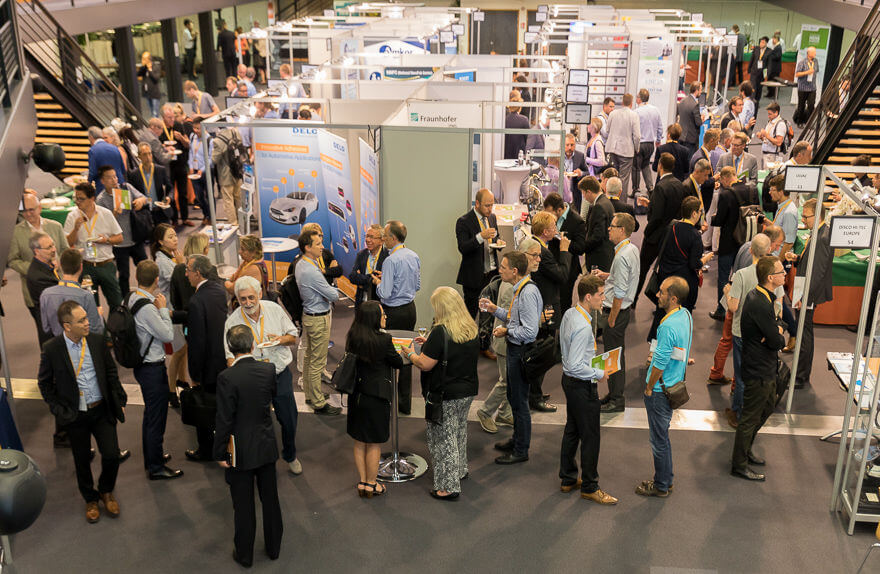 Last week, at the co-located 2018 European MEMS and Sensors/Imaging and Sensors Summits, held in Grenoble, France, I had the pleasure of gathering with 380 attendees from 21 companies from around the world to discuss the latest trends and technologies in MEMS, imaging, and sensors.
Last week, at the co-located 2018 European MEMS and Sensors/Imaging and Sensors Summits, held in Grenoble, France, I had the pleasure of gathering with 380 attendees from 21 companies from around the world to discuss the latest trends and technologies in MEMS, imaging, and sensors.
Topics of discussion included the latest MEMS, imaging, and sensor market trends; application spaces such as automotive electronics, healthcare, and smart cities; the power of combining artificial intelligence and machine vision; the importance of data protection; cloud vs. edge computing; and much more.
The highlight of the week was the Gala Dinner at the Restaurant le Teleférique – where we were treated to a breathtaking view of Grenoble from the Bastille, and the opportunity to network while enjoying delicious regional specialties.
Battles Lost and Won
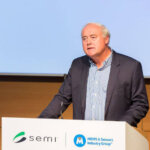
Jean-Marc Chery, ST Microelectronics, opened the event with a humble statement, declaring that the European semiconductor industry has failed to lead the way in innovation for consumer electronics. “I am ashamed to have participated in this battle lost to connect and inspire young people,” he said.
Chery issued a call to arms for the European MEMS, imaging and sensor industry to become the worldwide leader for automotive electronics, as well as smart health and smart cities. “This is the battle we must win for Europe and young people who want to live in Europe and raise families here,” he said. “We are the leaders in all the building blocks worldwide. Our mission is to help our European customers win this battle. We have the best technology and the strongest supply chain. If we can leverage this event to create this ambition effort, I have done my job today.”
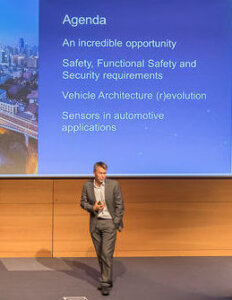
New Spins on Old Topics
This year’s presenters offered some new spins on old topics. In automotive electronics, we didn’t hear how close we are to full autonomy and how it’s going to make our lives much better. Rather, we heard about the importance of functional safety and security, and the recognition that now and in the future, people still like to drive and have no desire to hand over the keys in exchange for a world filled with robocars.
Several speakers emphasized the importance of preserving consumer privacy. This represents a major shift from years past, where it was suggested that Millennials freely forfeit their personal information in exchange for web-based goods and services.
This past year, security breaches and infringement on privacy by internet giants and governments have shown us the harm that can come to citizens by having a cavalier attitude regarding personal data. To achieve this, the intelligence of the sensor needs to happen at the “edge” vs. the cloud.
Why are we still calling them smartphones?
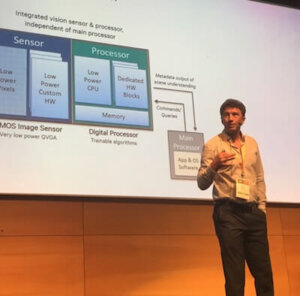
Just short of brushing our teeth for us, our smartphones are destined to become personal remote controllers.
According to Qualcomm’s Evgeni Gousev, with a global install base of 4B are the ideal platform for deploying artificial intelligence and machine vision to the market.
By integrating MEMS, imaging and sensor devices with the right algorithms, and integrating artificial intelligence (AI) and edge computing, smartphones are capable of managing everything from our health data to our home security systems.
Mark-Eric Jones, Léman Micro Devices, explained it best. His company makes FDA-approved sensing devices for vital sign monitoring. These devices go beyond the standard fitness tracker to monitor heart rate, blood pressure, blood gasses, and body temperature. “Hitching our cart” to smartphone companies vs. building stand-alone wearables was a conscious business decision, he said.
Rather than invest millions in mass-producing and marketing a device, this company is offering smartphone OEMs a way to add value in a way that might encourage consumers to upgrade, in a time where it takes more than a better camera or a bigger screen.
Megatrends driving MEMs
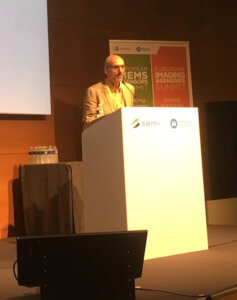
According to Yole’s Eric Mounier, we are in the midst of a new MEMS innovation wave, thanks to megatrends like smart automotive, healthcare, mobile, and industry 4.0. More waves will follow, and we are looking at a $100B market by 2023. From Mounier we learned that:
- MEMS-based lidar, particularly for automotive applications will be a $1B market.
- RF MEMS and oscillators are both boosting the MEMS market in CAGR and value
- Depending on the market segment, the value of MEMS sensors will increase anywhere from 10-30% by 2030
From Manuel Tagliavini, IHS Markit, we learned that in the space of four short years, Apple both created and destroyed the fingerprint sensor market. But it is creating a market for time-of-flight sensors and structured light sensors, by introducing facial recognition in its iPhone X.
There is still hope for fingerprint sensors if companies integrate finger sensing capability into the display, thereby eliminating the need to find the button.
What’s new in imaging?
Image sensors are still the largest market, according to Roland Berger’s Michael Alexander, thanks to their importance to both consumer electronics and automotive electronics. He also predicted a slowing for chemical sensing, as new sensing technologies emerge to replace them.
The big image sensing story wasn’t about making our smartphones into DLSR-quality cameras. it was about improving machine vision for healthcare applications, facial recognition, home security, and more.
As it turns out, image sensors for machine vision don’t need to be high resolution. It’s not about the images, it’s about the metadata. Conventional approaches to machine vision are power hungry, explained Gousev. Qualcomm has developed an image sensor that consumes less than 100 amps of power by reducing image resolution and focusing on algorithms for improved data output (Figure 2).
Asia MEMS Markets
Participants from China and Korea alike were interested in these summits as a way to tap into the European MEMS and sensor manufacturing community.
From Gao Teng, FIOT-LAB we hear about the current challenges facing China’s MEMS market. Despite the fact that there are lots of local MEMS players, the companies are too small to invest in MEMS innovation, and there is no venture capital to tap into. Rather, they are focused on the mature smartphone market, supplying commodity MEMS devices.
To address this, the Shanghai Industrial µTechnology Research Institute, (SITRI) has established a consortium of microfabrication and R&D lines to partner in an effort to create a MEMS and sensor innovation ecosystem for the internet of things (IoT) applications in China. FIOT-LAB is part of this ecosystem, and they are providing partnerships for European companies who want to do explore China’s MEMS markets and do business in the region.
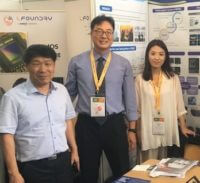
Likewise, Myeong Ho Song from the National NanoFab Center in Korea brought a small delegation of Korean companies to exhibit, in hopes of establishing a partnership with a European MEMS foundry (Figure 3).
He explained to me that the Nanofab Center was established to provide collaborative opportunities for MEMS R&D development in Korea, where most semiconductor manufacturing focuses on logic and memory (think: Samsung and SK Hynix)
The Nanofab Center’s technologies are targeting mobile computing MEMS and sensor applications. The foundry supports pilot programs, but technology is stalling at R&D because there is nothing in Korea to support volume manufacturing in MEMS, explained Song. He’s hoping to collaborate with a foundry that can take pilot programs to volume manufacturing.

Conclusion
Since its first incarnation as the European MEMS Summit in 2015, to last week’s version, I’ve enjoyed participating in these events to witness first-hand how the markets and technologies continue to evolve and change. It’s also interesting to see the power of a conference like this at work. It is through this type of event that technologists can be informed about what is needed from them now, and in the future.
Stay tuned for deeper dives in some of the week’s hottest topics: automotive electronics and smart cities. ~ FvT




